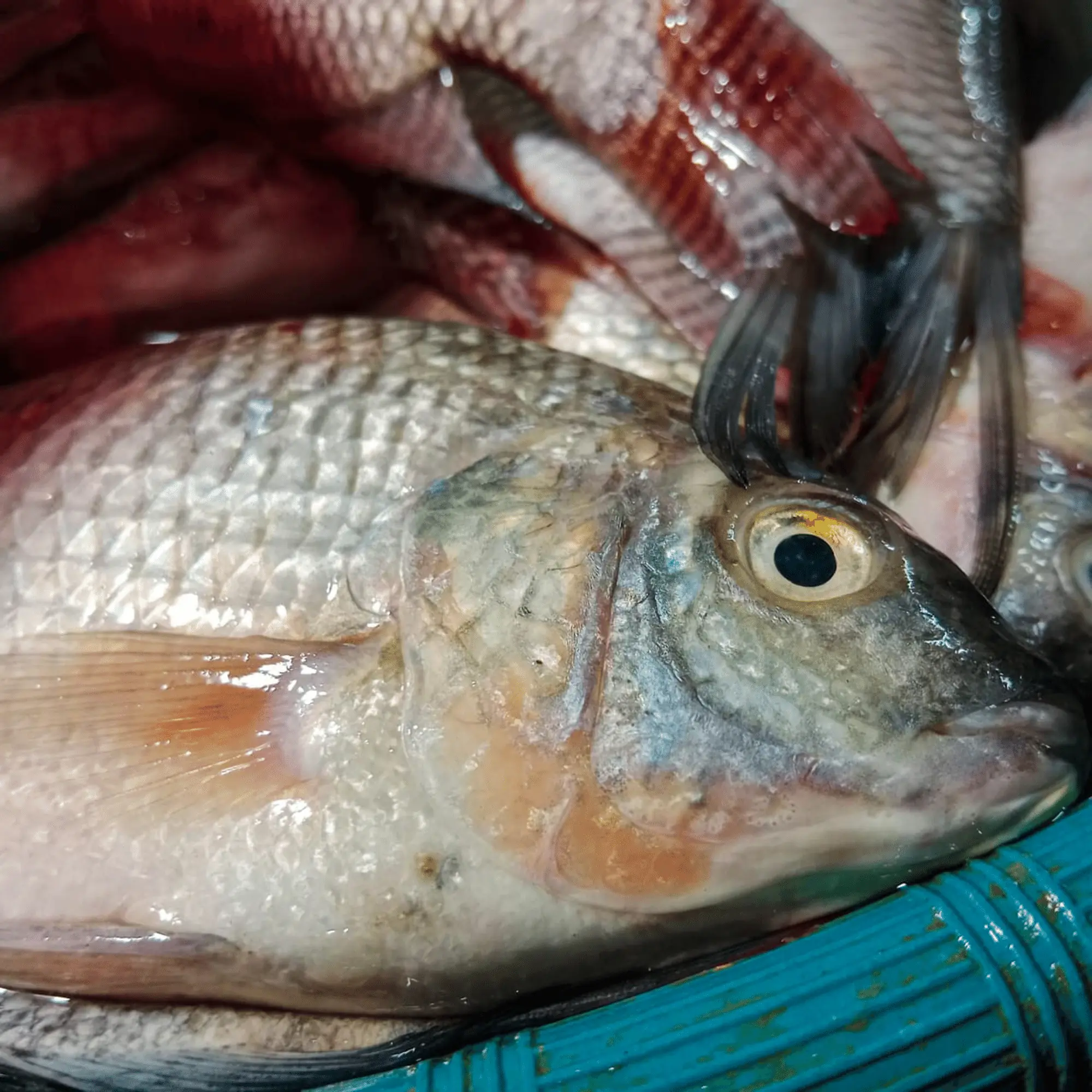As caring pet owners, we always want to make sure our dogs stay healthy. Sometimes, we wonder if certain human foods are okay for them to eat. One of those foods is tilapia, a type of fish that many people enjoy. Tilapia (Oreochromis niloticus) is a popular fish in the United States because it’s affordable and has a mild flavor that many people enjoy. Just like other fish, it’s packed with protein, minerals, and omega-3 fatty acids. But the question arises: can dogs eat it?
In this article, we’ll talk about whether it’s safe for dogs to eat tilapia. We’ll also look at the good things it can do for them and what we need to be careful about. This way, you’ll have all the information you need to decide if you want to give tilapia to your furry friend.
Here are the topics we’ll follow in this blog post:
- Can Dogs Eat Tilapia?
- Tilapia Is Good For Dogs But Keep Some Things In Mind
- Health Benefits of Tilapia for Dogs
- Risks of Tilapia for Dogs
- Can Dogs Eat Raw Tilapia?
- How to Incorporate Tilapia to Your Dog Safely
Can Dogs Eat Tilapia?
Yes. When it’s responsibly sourced and prepared correctly, tilapia can be a good choice for dogs. It’s a lean, protein-rich fish that can provide nutritional benefits for your pup. Remember to remove the skin and bones, cook it thoroughly, and serve it plain. And it’s always a good idea to consult with your veterinarian before introducing any new food into your dog’s diet.
Tilapia Is Good For Dogs But Keep Some Things In Mind:
It’s true that while Genus Tilapia can provide some nutrients beneficial for dogs, it’s not ideal to feed it to them too frequently. Here’s why:
- Tilapia contains selenium, niacin, and vitamin B12, which are beneficial for metabolism when consumed in trace amounts.
- Niacin helps in breaking down fatty acids, but too much can lead to liver problems and diarrhea in dogs.
- Similarly, excessive intake of selenium and vitamin B12 can result in severe gastrointestinal issues for dogs.
- Moderation is key when feeding tilapia or any seafood to dogs to prevent potential health problems associated with overconsumption of certain nutrients.
- Tilapia can be fed to dogs if it’s properly cleaned (skinned, deboned, and only boneless fillets are offered) and cooked thoroughly.
- This fish is low in calories and rich in protein, selenium, potassium, and vitamin D, but it contains a lot of phosphorus, which might not be suitable for dogs with kidney problems.
- Tilapia is often grown in poor conditions in polluted waters, so consider purchasing U.S.-grown or locally produced fish for a safer and healthier option.
- Ensure you know where your tilapia comes from to guarantee its quality and safety and to support sustainable fishing practices.
- Watch out for mercury content; although generally low, it’s wise to monitor your dog’s consumption to prevent any potential long-term health issues.
So, while tilapia can be part of a balanced diet for dogs, it’s important to offer it in moderation and consider other sources of nutrients as well.
Health Benefits of Tilapia for Dogs:

When prepared appropriately, tilapia offers several notable health perils for your furry companion.
1. Omega-3 Fatty Acids:
Tilapia is abundant in omega-3 fatty acids, particularly EPA (eicosapentaenoic acid) and DHA (docosahexaenoic acid). These essential fatty acids play a crucial role in supporting your dog’s skin and coat health.
They help maintain skin elasticity, reduce itching and inflammation associated with allergies, and promote a shiny, lustrous coat. Additionally, omega-3 fatty acids have anti-inflammatory properties that can benefit dogs with conditions such as arthritis or joint pain.
2. Protein Source:
Tilapia is a high-quality protein source, containing all the essential amino acids required for your dog’s muscle development and growth. Protein is essential for repairing and building tissues, supporting immune function, and providing energy.
Including tilapia in your dog’s diet ensures they receive the protein necessary to maintain optimal health and vitality.
3. Low in Saturated Fat:
Tilapia is a lean protein source, meaning it contains relatively low levels of saturated fat compared to some other meats. A diet low in saturated fat is beneficial for dogs as it helps maintain cardiovascular health and reduces the risk of obesity, pancreatitis, and other obesity-related conditions.
By incorporating tilapia into your dog’s diet, you can provide them with a nutritious meal without worrying about excessive fat intake.
4. Vitamins and Minerals:
Tilapia is rich in essential vitamins and minerals that are vital for your dog’s overall health and well-being. These include:
- Vitamin B12: Important for nerve function, red blood cell production, and energy metabolism.
- Selenium: Acts as an antioxidant, supporting the immune system and protecting cells from oxidative damage.
- Potassium: Essential for maintaining proper muscle function, nerve transmission, and electrolyte balance.
- Vitamin D: Promotes calcium absorption and bone health, contributing to strong teeth and skeletal development.
- Phosphorus: Important for bone and tooth formation, energy metabolism, and maintaining pH balance in the body.
- Palatability: Many dogs find tilapia to be palatable and enjoy its mild flavor and tender texture. Its taste may appeal to picky eaters or dogs with specific dietary preferences, making it a popular choice for adding variety to their meals.
- Digestibility: Tilapia is generally easy for dogs to digest, making it suitable for dogs with sensitive stomachs or digestive issues. Its mild flavor and soft texture make it less likely to cause gastrointestinal upset compared to some other types of meat.
- Versatility: Tilapia can be prepared in various ways, including baking, grilling, or steaming. This versatility allows you to tailor the preparation method to your dog’s preferences and dietary needs.
Whether served as a standalone meal or mixed with other ingredients, tilapia offers flexibility in meal planning and can be a valuable addition to your dog’s diet rotation.
Incorporating tilapia into your dog’s diet can provide a range of health benefits, including essential nutrients, lean protein, and palatability. However, it’s essential to ensure that tilapia is cooked thoroughly and served without any seasonings or additives that could be harmful to dogs.
Risks of Tilapia for Dogs:
While tilapia can be a tasty addition to your dog’s diet when prepared carefully, pet parents need to be aware of the potential pitfalls associated with feeding their furry companions tilapia.
1. Possible Allergic Reactions:
Like any new food, some dogs may have allergies to tilapia. Symptoms of an allergic reaction can include itching, vomiting, skin irritation, or diarrhea. It’s crucial to introduce tilapia gradually into your dog’s diet and monitor them closely for any adverse reactions.
If you notice any signs of an allergic reaction, discontinue feeding tilapia immediately and consult with your veterinarian.
2. Choking Hazard:
The bones found in tilapia can pose a choking hazard for dogs. Fish bones are brittle and can easily splinter when chewed, potentially causing them to become lodged in the esophagus or gastrointestinal tract.
This can lead to choking or internal injuries, which may require surgical intervention to resolve. To mitigate this risk, always choose boneless tilapia and carefully remove all bones before feeding it to your dog.
3. Mercury Contamination:
While tilapia is generally considered a low-mercury fish, it’s still important to moderate your dog’s intake to minimize potential long-term health risks, especially for smaller breeds.
Since there are currently no regulations for mercury levels in pet foods, it’s advisable to avoid or limit feeding your dog fish-based foods in general as a precautionary measure.
4. Bacterial Contamination:
Undercooked tilapia, like any undercooked fish or meat, can harbor harmful bacteria that may pose a risk of foodborne illness to your dog. It’s essential to cook tilapia thoroughly to kill any potentially dangerous bacteria and ensure it’s safe for consumption.
Avoid feeding your dog raw tilapia or raw fish, as they can contain bacteria and parasites that may compromise your dog’s health. Proper handling, storage, and cooking techniques are essential to minimize the risk of bacterial contamination.
By being aware of these potential risks and taking appropriate precautions, you can safely incorporate tilapia into your dog’s diet as a nutritious and enjoyable treat.
Can Dogs Eat Raw Tilapia?

Feeding your dog raw fish, including tilapia, can cause serious health problems. Raw fish can contain harmful parasites and bacteria that can make your dog sick. This is especially dangerous for puppies, who have more sensitive stomachs.
Fish bones can be very dangerous. They can splinter and cause painful injuries or blockages in your dog’s throat or stomach. Always make sure to remove all bones before feeding fish to your dog.
If your dog eats raw fish, look out for these symptoms and contact your vet if you notice:
- Lack of appetite
- Vomiting
- Scooting
- Diarrhea
- Swollen abdomen
- Dull coat
- Itching
- Bald spots
- Weight loss
- Fever
Fish raised on farms are less likely to have parasites than wild-caught fish. Freezing fish can kill parasites, but it’s still best to avoid giving raw fish to dogs altogether. By feeding your dog only cooked fish, you can prevent these issues and keep your pet healthy and happy.
How to Incorporate Tilapia into Your Dog Safely?
If you want to add this nutritious fish to your dog’s diet, it’s important to know how to cook tilapia specifically for dogs. Below are some strategies to keep in mind:
1. Source it Responsibly:
When buying tilapia, choose sustainably wild-caught fish and avoid farm-raised tilapia. Wild-caught fish typically have a more natural diet and are less exposed to diseases and contaminants like antibiotics and pesticides.
Additionally, farm-raised fish have a greater environmental impact due to water pollution and resource use.
2. Cook it Properly:
Make sure to remove all bones and skin from the tilapia and cook it thoroughly. The best methods are steaming or baking, as these retain the most nutrients.
The tilapia should be cooked until its internal temperature reaches 145 degrees Fahrenheit, which typically takes 10–15 minutes in the oven at 425 degrees or 5–10 minutes in a steamer.
3. Keep Portion Sizes Small:
While tilapia is healthy, it’s important to serve it in small amounts to avoid overfeeding.
Break the fish into small pieces to make it easy for your dog to eat and digest, meeting their nutritional needs without causing digestive issues.
4. Don’t Feed it Frequently:
Moderation is key with any treat. Offer tilapia occasionally rather than regularly to keep it a special and safe part of your dog’s diet.
5. Consult Your Vet:
Always consult with your vet before introducing any new food into your dog’s diet, including tilapia. This helps ensure it’s safe and appropriate for your dog’s specific health needs.
Tilapia can be a great addition to your dog’s diet when sourced responsibly and prepared correctly. However, it’s best to feed it in small quantities due to potential mercury contamination. By following these tips, you can safely and healthily incorporate tilapia into your dog’s meals.
Final Thought:
Tilapia can be a healthy and nutritious addition to your dog’s diet when prepared and served correctly. This fish offers numerous health benefits, including high-quality protein, essential vitamins and minerals, and omega-3 fatty acids, all of which contribute to your dog’s overall well-being. However, it is crucial to source tilapia responsibly, cook it thoroughly, and remove all bones and skin to ensure it is safe for your pet.
Moderation is key, as too much genus tilapia or frequent servings can lead to potential health risks, such as mercury contamination and gastrointestinal issues from excessive nutrients. Additionally, always avoid feeding raw tilapia or any raw fish to your dog due to the risk of parasites and harmful bacteria.
Consulting your veterinarian before introducing tilapia or any new food into your dog’s diet is essential to ensure it meets their specific health needs. By following these guidelines, you can safely incorporate tilapia into your dog’s diet as an occasional treat, providing them with a tasty and nutritious meal that supports their overall health.
FAQs:
How do I cook tilapia for my dog?
Avoid using oil, butter, or spices like garlic and onion when cooking tilapia for your dog. These can upset their stomachs, and some spices are toxic. Instead, bake or steam the tilapia to keep it healthy. After cooking, break it into small pieces and add it to your dog’s regular food or give it as a treat.
What fish can dogs not eat?
Other fish to avoid due to high mercury levels include albacore tuna, swordfish, and king mackerel. If you decide to give your dog a small portion of tuna as an occasional treat, choose tuna without any additives. Be cautious with canned tuna, as the oil used in it can be problematic for dogs.
What fish is best for dogs?
“Tuna, salmon, whitefish, cod, and whiting are all safe and healthy for dogs to eat,” says Dempsey. “Purina includes fish in our foods because it provides many important nutrients for dogs,” Dempsey explains. Plus, dogs enjoy the taste of fish too.
Is tilapia easy for dogs to digest?
Tilapia and sweet potatoes make a great meal for dogs with allergies and digestive issues. This recipe is easy to digest and packed with omega-3 fatty acids. Fish is especially good for senior pets and those with sensitive stomachs.












